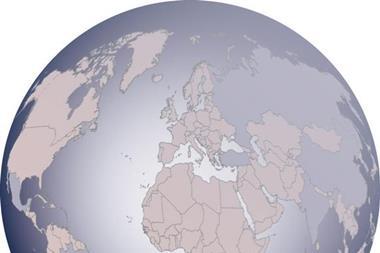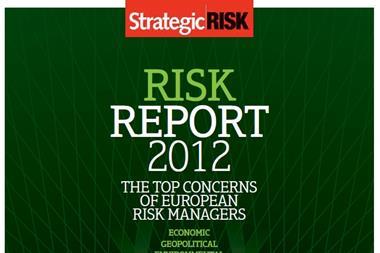Global economic instability and natural catastrophes are putting more pressure on the corporate supply chain than ever before. Recurring liquidity crises in the eurozone and last year’s Japanese earthquake highlighted how tightly stretched supply chains are within businesses worldwide. Globalisation is clearly a double-edged sword.
In May 2012, StrategicRISK published its annual Risk Report, in association with marsh Risk Consulting, which outlined the views of leading risk managers and identified the pertinent issues dominating the risk landscape. Here is a snapshot of its findings.
Economic risks
Whether the euro can remain a viable currency is weighing heavily on all risk managers’ minds, leading many companies to review the currencies they use to buy and sell. Recurring liquidity crises and the extreme volatility in agricultural and energy prices are causing geopolitical tensions and the rise of social inequality.
One risk manager says: “There are always uncertainties surrounding who you’re dealing with and the currency you’re
dealing in. If our suppliers are experiencing problems, either in getting access to credit or securing credit insurance, it creates dii culties in our sourcing supply chain and drives up costs.”
Severe fluctuations in fuel prices, meanwhile, have already caused some smaller airline companies, such as Spain’s
Spanair and India’s Kingfisher, to collapse. Global social unrest continues to threaten the political stability of an increasing number of countries. As another risk manager put it: “Recent developments in the Middle East and North Africa have added an element of political risk. For example, Libya’s shutdown of a refinery or Iran cutting of supplies causes a spike in the price. But there are also long-term concerns over steadily growing demand and a limited supply.”
Geopolitical risks
Terrorism and the consequences of last year’s Arab Spring are among the biggest risks for international companies.
Global governance failure is the top-ranked issue and the disconnect between global economies and legislative systems has led to unsustainable population growth, rising greenhouse gas emissions, critical systems failure and chronic fiscal imbalances.
Giampaolo Scarso, head of Marsh Risk Consulting, Italy, says: “Geopolitical factors such as widespread illicit trade, pervasive entrenched corruption, the failure of diplomatic confl ict resolution, terrorism and unilateral resource nationalisation could alter fair and regular international trade.”
The World Bank has now openly discussed the problems of institutional corruption and believes this is the single greatest obstacle to economic and social development.
Environmental risks
In the past two years, the World Economic Forum has focused on risk interconnectedness in its own Global Risks report. Natural disasters have always led to severe accumulations of risk but losses mainly involved property in the af ected areas and did not spread to other regions.
Globalisation has created corporate supply chains that are interwoven and integrated by partnerships and outsourcing deals. The earthquake and tsunami in Japan, for example, resulted in car makers worldwide suspending production and electronics firms issuing profit warnings.
One risk manager says: “Climate change can only continue to increase the severity of such events. This has potential consequences for both the company’s activities and its insurance programme. It’s uncertain whether the insurance market will continue to maintain the same level of natural catastrophe coverage.”
Societal risks
Overpopulation and the dynamics of human survival, against water shortages and chronic diseases for example, are helping shape riskmanagers’ contingency plans and coping strategies. The biggest worry is the imminent threat of a potential pandemic, such as the recent avian and swine fl u scares, though mass casualties were averted. Travel restrictions create disruption and the cost of business interruption claims can amount to millions, if not billions, on a global scale.
“Pandemic risk is not a question of ‘if’ but rather ‘when’. Our response still relies too much on the triggers set out by the World Health Organisation,” says one risk manager.
Eventually water will become a commodity traded like oil and gas and shortages of water supplies, as the recent UK drought shows, have not been taken seriously enough in risk assessments. Potential “water wars” in the future could undermine governments and generate new levels of geopolitical risk.
Social inequality and the ever-growing rise in religious fanaticism are also far-reaching issues that are out of the control of the risk manager. All a company can do is try to mitigate its exposure. According to one European risk manager: “From a business perspective all you can hope for is to be in a better position at the turnaround. That’s why it’s so important as a business to maintain market share during these times.”
Technological risks
Cyber neo-tribalism is how the World Economic Forum’s Global Risk report describes the growing threat from anti-capitalism groups such as Anonymous and the Occupy movement. Cyber attacks have shifted from the malicious or fraudulent hacker to hackers who wish to make political statements or are motivated by ideas rather than financial gain.
The effects of some cyber crimes, such as theft of corporate secrets, are not felt for years, while others are instantaneous and carry serious reputational risks. “The growth of social media networks has encouraged users to express themselves freely and many people are oblivious to the hidden dangers,” says one risk manager. “There is a tendency to believe only the young are reckless in sharing information online, but many executives are equally careless.”
Unintended consequences of nanotechnology and the increasing occurrence of solar fl ares, which can influence weather and produce electromagnetic pulses, are some of the future risks highlighted by industry experts.
Many risk managers conceded in the report that “there is no point” in looking for an insurance solution to protect against all cyber risks “because one probably doesn’t exist”. Protecting the residual risk is the best most risk managers can hope for, once the basic risk management exercise has been completed.




















No comments yet